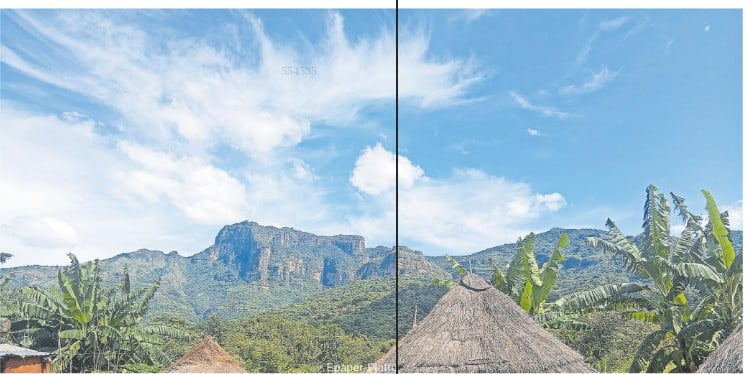Prime
Thrills of tracking mountain gorillas

Warden briefs tourists before gorilla tracking. PHOTO BY ESERI WATSEMWA
What you need to know:
- Minimum trackers: A maximum number of eight visitors may visit a group of habituated mountain gorillas in a day. This minimises behavioural disturbance to the gorillas and the risk of their exposure to human-borne diseases.
- Hygiene is a must : Do not smoke, drink or eat when you are near the gorillas. Eating or drinking inevitably will increase the risk of food, drink morsels or droplets falling, which could increase the risk of transmission of diseases.
- No flash photography :It begins with keeping your voices down while you approach or are with the gorillas. Also, flash photography is not permitted. When taking pictures move slowly and carefully. The tracker guides recommend using films of 400-800 ASA.
- AWESOME APES. Gorillas got intimate, posed for the camera, threatened to fight but live in harmony, writes ESERI WATSEMWA.
Males fight or struggle for dominance even when it comes to mountain gorillas.
Our team leader announced that we would go gorilla tracking. This kept me awake half of the night. I had longed to see the mountain gorillas away from travel magazines. The rest of the team who had jetted into the country for the 2017 tourism expo were not any better.
Off we went
We set off at 7.30am. Benson Kanyonyi, a ranger guide, briefed us for about 10 minutes and we were divided into two groups.
Rukara’s (the dominant gorilla) visitors, were led by John Baptist Tugumisiriza, a ranger guide. We trekked downhill, uphill and downhill again, tracking the famous gorillas. Much as we wanted to see them, we were afraid of them. At one point the slippery terrain forced us to move on our behinds. The Baganda call it gogolo. There were many falls too.
Rukara was a few metres beneath where we stood, panting and sweating away in the cold. We moved closer, this time with more energy than we had gathered. At a distance, we could see strange animals barking softly and hooting. Then, their hairy chests saw all cowards fleeing. We moved closer and closer.
Nature of the ape
The gorilla is a peaceful animal, when not attacked or threatened by humans. One laid her sturdy fingers on me. “Stay still,” the guide whispered. She yawned and headed to the bigger gorilla, Rukara. This giant silverback is the ‘king’ of the Kyaguriro group. Like his name, he is very black with a big head.
Rukara, 28, has been struggling for power with 17-year-old Mukiza. The two have divided the ‘kingdom’ into two. Rukara’s group has eight gorillas, while as Mukiza’s has 11. The other groups are Oruguzo, with 18 gorillas and Bitukura which was headed by the late dominant male, Ndahura. It has 12 gorillas.
The ‘women’ love Rukara, despite his age. One Tindamanyere hangs around him most of the time. She caresses Rukara’s back with her black unkempt fingernails. Other females stared on and moved around, probably to get recognised by the dominant male who kept aloof. He lay there, enjoying every moment until strange noises distracted him. He stood up, stretched from the ecstasy and dashed in its direction.
“Rukara has heard Mukiza. He is coming to attack him because this female [Tindamanyere] has been with him for close to a week and is now back here with Rukara. He is furious,” Tugumisiriza said.
Rukara had injuries on his fingers. Tugumisiriza said he had previously fought with Mukiza, over the same ‘woman’. “He is now back. Imagine he has left all the others just to claim his wife,” he explained.
At that point, everyone wanted to witness the fight, although they feared the outcome. “What if he attacks us?” one of us asked.
“No, gorillas think like us. When Mukiza gets here and the fight is on, the rest of the gorillas in this group will join Rukara to fight him. But if they feel overwhelmed, they will come to you (their cousins) to intervene. This sent every one into laughter but we were scared.
Posing for the camera
When Mukiza arrived, he instead paused for the cameras and plucked twigs to eat.
“You see, he sometimes comes just to have a good time with Rukara but he thinks he has come to fight,” he explained. When all the women settle at Mukiza’s, Rukara doesn’t react. The women love him and will always come back. Probably Rukara understands Mukiza is only an ambitious youth hungry for power.
The gorillas were comfortable in our presence. They relaxed in the shrubs while we enjoyed taking photos in all angles.
George Businge, a warden in charge of Ruhija sector, said Bwindi Impenetrable National Park (BINP) in south-western Uganda has 400 gorillas, found in the four sectors; Buhoma, the oldest sector north of Bwindi, Rushaga (southern Bwindi), Ruhija (north-eastern) and Nkuringo, in the south.
Gorilla tracking has been the most tiring, yet the most exhilarating experience by the hosted buyers or tourists who are in the country, sampling Uganda’s tourism sites prior to the 2017 tourism expo.
The deal is
Uganda has 400 mountain gorillas, out of a total of 880 in the world. “The park is also a special home for chimpanzees, about 120 species of mammals, seven to eight primates, four species of monkeys, baboons, over 200 species of butterflies, 24 bird species, and reptiles such as chameleons, snakes, lizards, black mamba,” said Sunday Charles Ndayankunze, Assistant warden, Tourism, BINP.
It is also a park where animals and different communities of people live in harmony, with a few cases of poaching where snares are laid to trap animals for game meat end up, on a few occasions, trapping gorillas.
Rules of the thumb: Compiled from gorilla-tracking-uganda.com
Minimum trackers
A maximum number of eight visitors may visit a group of habituated mountain gorillas in a day. This minimises behavioural disturbance to the gorillas and the risk of their exposure to human-borne diseases.
Hygiene is a must
Do not smoke, drink or eat when you are near the gorillas. Eating or drinking inevitably will increase the risk of food, drink morsels or droplets falling, which could increase the risk of transmission of diseases.
No flash photography
It begins with keeping your voices down while you approach or are with the gorillas. Also, flash photography is not permitted. When taking pictures move slowly and carefully. The tracker guides recommend using films of 400-800 ASA.




